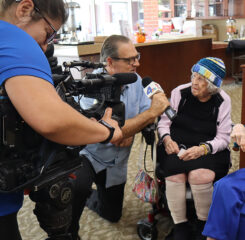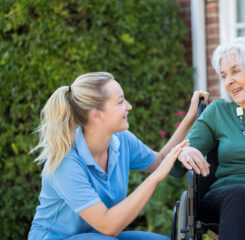Living with COVID: Week 12
This Week’s Highlights:
Volume Twenty-One: Air Date 6.6.22. “Long COVID and Disability Advocacy”
This morning’s Washington Post features a very thought-provoking article on long COVID and how we think about – and advocate for – people living with disability. According to the article, the COVID pandemic has added somewhere between 7 and 23 million people – called “long haulers” – to the over 61 million adults who live with long term disability in America. These are people who are suffering long-term disabilities from a COVID infection, and their lives have been significantly disrupted by both the physical and emotional challenges that long COVID presents. The lived experience of the “long haulers” runs a broad spectrum, too: some are living with disabilities that significantly disrupt their lives; some are grappling with a new identity of being “disabled” and what kind of “spoonie” they are (and a “spoonie” is someone who measures their daily energy limitations in “spoonfuls” of energy); yet others have ‘invisible’ disabilities that they don’t even realize categorizes them as “disabled.”
With so many more people now meeting the definition for ‘disabled’ under the ADA, disability advocates are trying to figure out how to include the “long haulers.” This massive influx has revealed both opportunities and some, you could say, dirty laundry within the disability communities.
On the one hand, many disability advocates take what they call a “big tent” approach, seeking to gain greater influence on shared policy and funding goals by with united and coordinated advocacy efforts. There was some success on this front within the last two years’ COVID legislation; while initial funding packages did not have much in terms of special earmarks for disability communities, later packages and/or proposals did have targeted and intentional program funding specifically for people living with disabilities. Many view this as a win for the overall disability community advocacy efforts and had some gratification that years of advocacy work received a big “push” from the long -COVID focus of the pandemic.
Also, there are reportedly mixed feelings within the disability communities about this COVID surge in disabled persons. Already at times rifle with internal tensions between groups that are fighting for the same limited funding opportunities, the disability community has some individuals who feel resentment that the COVID “long haulers” have received instantaneous attention and funding that has long eluded their own disability groups – some of which represent people who have similar symptoms and physical/ emotional/ or mental limitations that they have lived with since birth.
And, with good reason, there are mixed feelings. There are “stark statistics” on people who live long-term with disabilities: “the Census’s 2020 Supplemental Poverty Measure suggests people with disabilities experience poverty at double the rate of nondisabled people. They earn on average 74 cents on the dollar compared with nondisabled workers. And they experience food insecurity at three times the rate of nondisabled people.”
On the whole, though, from an advocacy and policy change perspective, the additional attention and importance being given to serving the needs of the disability community is a positive. “We’re at this real confrontational moment of trying to educate as many people as possible about disability and structural inequalities and trying to make sure [long haulers] get the resources they need right now,” said Mia Ives-Rublee, director of the Disability Justice Initiative at the Center for American Progress.”
As summed up by Lisa McCorkell, a co-founder of the Patient-Led Research Collaborative, “The benefit of millions of people getting sick all at once, is we have remarkable access to people and power that others have struggled to get for a long time. I want to make sure that I am representing those people.
Let us hope that this collaborative spirit not only persists, but perseveres. It is a powerful reminder that there are some moments in time – even in the most difficult times – to capture the momentum and really move advocacy efforts forward. LeadingAge has been working tirelessly to do just that.
Volume Twenty-Two: Air Date 6.8.22. “Nuvaxovid: The New COVID Vaccine”
Yesterday, the FDA’s independent advisory panel voted overwhelmingly to recommend that the FDA authorize Nuvaxovid, a COVID-19 vaccine made by Novavax, for use in adults. The FDA’s vaccine advisory panel voted 21-0, with one abstention. The FDA does not have to follow the panel’s recommendation, though it often does.
Novavax’s two-dose vaccine was about 90 percent effective at preventing mild, moderate and severe COVID-19 during clinical trials. It is easy to store and transport and lasts at refrigerator temperatures for months, unlike the mRNA vaccines. However, the trials were conducted before the omicron variant came along, and panel members expressed concern about whether the efficacy would hold up against the current variants.
Forty other countries have approved Nuvaxovid for use. This vaccine could appeal to people who have been reluctant to receive one of the mRNA vaccines, as the protein-based shot was manufactured using a fundamentally different process. Protein-based vaccines like Novavax’s work by getting the body’s immune system to recognize little modified pieces of the virus. In Novavax’s case, that means pieces of the coronavirus spike protein. The hepatitis B and pertussis vaccines are examples of this protein-based approach.
Although most adverse reactions to the vaccine were mild to moderate and lasted just a few days, there were rare events of myocarditis and pericarditis. An increased risk of myocarditis and pericarditis has been identified among people who received the mRNA Pfizer/BioNTech and Moderna Covid-19 vaccines, as well. There is general agreement that the benefits outweigh these rare instances of heart problems.
In addition to offering an option for those fearful of the mRNA technology or resisting it on religious grounds, Novavax sees its vaccine as a potential option for booster doses, regardless of which type of vaccine was given for a person’s initial doses. If the FDA gives the green light, the company plans to seek authorization as a booster in adults as well as in adolescents and children. It is not clear when doses would be available or in what quantity. Novavax is also engaged in trials of a booster that specifically targets the omicron variant.

Most Recommended
November 08, 2024
 HOTMA: New Rules for Housing
HOTMA: New Rules for Housing
November 06, 2024
 Colleagues on the Move, November 6, 2024
Colleagues on the Move, November 6, 2024
November 06, 2024
 Analysis: What Does the Final CY2025 Home Health Rule Include?
Analysis: What Does the Final CY2025 Home Health Rule Include?
October 29, 2024
Katie Smith Sloan Urges Members to Build a Movement, Take Action
Recently Added
December 10, 2024
4 Top Tech Themes from 2024
December 09, 2024
 Analysis: What’s Changing with the Home Health CAHPS Survey?
Analysis: What’s Changing with the Home Health CAHPS Survey?
December 09, 2024



